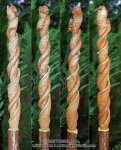Step 22: You can harvest fresh honeysuckle vine to use on your Sassafras twist cane.
Select second year growth or older - it will have a brownish tone to the paper-like bark. Green tone bark is first year growth and often is not strong enough to dry well.
Roll the vine into a loose circle and hang in a dry, dark space for about 3 weeks. This is long enough for the vine to loose most of its sap and moisture, but still be pliable enough for curling.
Strip the paper bark layer from the vine before you add it to your walking stick Sassafras carving. Honeysuckle looses its bark easily. If you leave the bark on the vine only the bark layer will be attached during the gluing. When the bark is shed you will lose the vine around your cane.
You can also purchase pre-dried, pre-striped honeysuckle vine, seagrass, raffia, and even paper rope from most baste weaving supply stores to use with your canes. Irish_twistie_cane_0069.jpg
Try Save-On-Crafts.com -
http://www.save-on-crafts.com/wi1.html
Seagrass, raffia, and Paper Rope -
http://BasketPatterns.com
Soak your vine in warm (not hot) water for about 10 minutes. Lightly blot on a dry towel to remove the excess water from the outer surface.
Check the thickness of your vine - the thinner part of the vine should be at the top of your stick, with the thicker, older growth, at the bottom. Using super glue, place several drops into the vine trough on your carving then place the vine into the trough. Hold in place for about 1/2 minute. Work just one or two inches at a time, slowly rolling the vine around the
cane. - Irish_twistie_cane_0070.jpg Irish_twistie_cane_0071.jpg















 Thanks, will take a couple days to read and digest all of this.
Thanks, will take a couple days to read and digest all of this.














